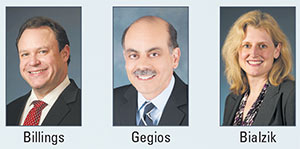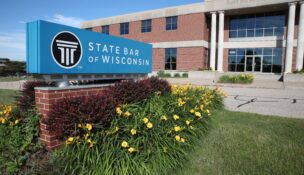ACT 235 REVISITED: Further analysis of civil-procedure changes
By: WISCONSIN LAW JOURNAL STAFF//January 25, 2019//
ACT 235 REVISITED: Further analysis of civil-procedure changes
By: WISCONSIN LAW JOURNAL STAFF//January 25, 2019//

Last summer, we wrote an article, “Sweeping Changes to Rules of Civil Procedure,” published in the June 2018 issue of the Wisconsin Lawyer. Our article was designed to be a neutral and factual accounting, for the benefit of the Wisconsin bench and bar, of the significant recent changes to Wisconsin’s Rules of Civil Procedure.
In their opinion piece “Please, not so fast! The haste to alter the rules of civil procedure” in last month’s issue of the Wisconsin Law Journal, the Honorable Eugene A. Gasiorkiewicz and William C. Gleisner discussed our article as a means to criticize the substance of those changes, and the manner in which the Wisconsin legislature enacted them. Because these matters (and our article discussing them) continue to be the subject of spirited debate, and to give readers context for the commentary in “Please, not so fast,” we reprint our article in this issue of the Wisconsin Law Journal. We hope this article provides the Wisconsin legal profession with a deeper understanding of the new rules.
Lawmakers, judges and lawyers have all struggled to find the appropriate balance between the ideas of liberal discovery, designed to ensure that every party can secure the best facts to support its positions, and the rising cost of litigation, much of which is spent on discovery, especially of electronic information.
With the chief stated aim of making litigation in Wisconsin courts less expensive, the Wisconsin Legislature in 2018 established new rules that greatly alter Wisconsin civil procedure. The rules, enacted in 2017 Wis. Act 235,1 will undoubtedly affect the balance between the pursuit of a case’s merits in discovery and the expense of that pursuit. The act also reduces the statutory limitations or repose periods for several causes of action, deals with third-party litigation funding and reduces the interest rate on overdue insurance payments, among other revisions to Wisconsin law. All civil litigants in Wisconsin courts need to be aware of these important changes.
The act’s unusual history
 Normally, the Wisconsin Supreme Court proposes new rules of civil procedure through a deliberative process that includes the Wisconsin Judicial Council, which is a body of judges, legislators, lawyers and academics who advise the supreme court on rule changes and civil practice. After receiving advice from the Judicial Council, the supreme court is required to hold a public hearing before any changes are approved, and to delay implementation to give lawyers and judges time to comprehend the changes.
Normally, the Wisconsin Supreme Court proposes new rules of civil procedure through a deliberative process that includes the Wisconsin Judicial Council, which is a body of judges, legislators, lawyers and academics who advise the supreme court on rule changes and civil practice. After receiving advice from the Judicial Council, the supreme court is required to hold a public hearing before any changes are approved, and to delay implementation to give lawyers and judges time to comprehend the changes.
In a significant departure from standard practice, the Legislature exercised its powers under Wis. Stat. section 751.12 to carry out the changes directly, without consulting or involving the Wisconsin Supreme Court or the Judicial Council. Although the act was supported by several local and national business and advocacy groups, legal groups objected to the Legislature’s decision to make sweeping changes to Wisconsin procedural law without using the standard rule-making process.
New discovery rules
The act deals with several unrelated subjects, but most of its provisions amend the Wisconsin Rules of Civil Procedure. Many of the changes mirror the 2015 amendments to the Federal Rules of Civil Procedure.
The new proportionality standard
Most importantly, the act adopts the proportionality standard from the 2015 Federal Rules amendments. Under the federal rules and now Wisconsin law, parties may obtain discovery regarding non-privileged matters that are relevant to any party’s claims or defenses and proportional to the needs of the case, considering:
- The importance of the issues at stake in the action;
- The amount in controversy;
- The parties’ relative access to relevant information;
- The parties’ resources;
- The importance of the discovery in resolving the issues; and
- Whether the burden or expense of the proposed discovery outweighs its likely benefit.2
Although the material or information sought must be both relevant and proportional, it need not be admissible in evidence to be discoverable.3
Adopting a proportionality standard as part of the scope of discovery4 was one of the key aspects of the 2015 amendments to the federal rules, which grew out of the Duke Conference, a gathering of judges, lawyers and professors held in 2010 to consider revisions to the federal rules. Participants noted that the costs of discovery in civil litigation are often out of proportion to the issues at stake, resulting in meritorious cases not being filed, being settled too quickly, or being pursued in alternative dispute vehicles such as arbitration.5
Although many participants expressed concern that the idea of proportionality would ultimately favor defendants, the advisory committee on the federal rules ultimately concluded that, with careful specification of the factors to be considered when evaluating proportionality, the rule changes would, on balance, lower the cost of litigation and improve federal practice.6 Wisconsin courts will have the benefit of the early federal experience in interpreting this new standard.
Adopting the 2015 federal-rules amendments
The act also follows the 2015 federal-rules amendments by including provisions making explicit that: 1) it is the obligation of both courts and parties to ensure the just, speedy and inexpensive determination of actions;7 2) courts, in responding to a motion for a protective order, may allocate expenses for producing the discovery in question;8 3) objections to document requests must be stated with specificity; and 4) copies of requested documents must either be produced with written responses to document requests or within a reasonable time specified in the written responses.9
Notable 2015 federal-rules amendments not adopted
Significantly, the act does not adopt the 2015 amendments to Federal Rule 37, which changed the possible penalties for failing to preserve electronically stored information and required showings for challenging a party’s failure to preserve such information.10
The act also does not include the 2015 changes to Federal Rule 16, which governs initial scheduling conferences, encouraging federal judges to have “sustained, active, hands-on judicial case management.”11 Proponents of the 2015 Federal Rules amendments argued that the discovery changes would work in tandem with early, active case management to help bring about productive discussions between courts and counsel about proportionate discovery, helping shape the course of litigation.12 It is unclear how well Wisconsin’s partial adoption of the 2015 Federal Rules will work without the active case management the federal courts employ.
Changes that adopt pre-2015 federal rules
The act also adopts language from certain pre-2015 amendments to the federal rules, including allowing parties to stipulate to the sequence and timing of discovery methods, providing a general cap (unless stipulated or otherwise ordered) limiting to 10 per side the number of depositions in a case (and limiting each deposition to seven hours), and limiting to 25 the number of interrogatories any party may serve.13 However, the act breaks from the Federal Rules by providing that depositions and interrogatories14 must be held to a “reasonable number,” thus imposing an additional restriction.
Like the pre-2015 federal rules, the act also now makes explicit that failing to produce copies of documents in response to a document request is sanctionable.15 Previously, only failing to make or agree to make documents available for inspection was expressly sanctionable under Wis. Stat. section 804.12. Given that the production of copies is far more common than inspection, the act clarifies that a failure to produce is also sanctionable.
Automatic stay of discovery after pleadings motions
The act provides that filing a motion to dismiss, for judgment on the pleadings, or for a more definite statement, automatically stays all discovery until 180 days after the motion is filed or the motion is decided16, whichever happens first. A party may move the court on good cause for particular discovery during this stay.17 This stay is a mandatory restriction on discovery not found in the current federal rules.
Limiting cumulative or duplicate discovery and cost-benefit considerations
The act further provides that the court, on motion, “shall” limit the frequency or extent of discovery if any of the following are true: 1) the discovery is cumulative or duplicative; 2) it can be obtained from another source that is more convenient, less burdensome, or less expensive; 3) the burden or expense of the proposed discovery outweighs the likely benefit; or 4) the burden or expense of the proposed discovery is not proportional to the needs of the case (listing a set of factors relevant to proportionality that is comparable, but not identical, to the proportionality factors outlining the scope of discovery).18
This language is similar to the language of Federal Rule 26 (and even closer to the pre-2015 version of that rule), but with significant differences. Federal Rule 26 provides that the court must limit discovery if it is unreasonably cumulative or duplicative. The act removes the word “unreasonably,” making it possible to interpret it as meaning that any cumulative or duplicative discovery is prohibited, even if there are compelling reasons, such as credibility determinations, for seeking overlapping evidence on some issues.
More importantly, the act provides that the court “shall” limit discovery if the burden or expense of providing the discovery outweighs its likely benefit, or if the discovery is not proportional to the needs of the case. Under Federal Rule 26, likely benefit is considered in conjunction with the other proportionality factors, not as a separate test. Thus, unlike the Federal Rules, the act requires a court to perform an independent weighing of cost versus benefit, divorced of all other issues. If the discovery sought does not pass this test, the court “shall” limit it.
The federal rules have never imposed that additional test, and it may be difficult for a requesting party to establish, standing alone, that the likely benefit of evidence it has never seen will outweigh its costs. To that extent, this test may skew in favor of limiting discovery, to the prejudice of any party needing additional evidence to support its claims or defenses.
Moreover, in the 2015 amendments to the federal rules, “likely benefit” is the last of the proportionality factors (which are listed in order of importance).19 By making likely benefit versus cost and expense an independent test for whether material or information is discoverable, the act imposes a new restrictive standard not found in the federal rules.
The new language also sets up a curious asymmetry in the Wisconsin Rules of Civil Procedure. To be within the scope of discovery, material or information sought must be proportional to the needs of a case, with “likely benefit” being just one of many other factors to consider in evaluating proportionality.20 However, if a discovery request is challenged by a motion, the court “shall” limit the discovery if the burden or expense outweighs the likely benefit, irrespective of any other proportionality factor (such as importance of the issues, relative access to information, amount in controversy, etc.).21
The legislative history does not explain why the act gives rise to this discrepancy, or why the act does not simply (like the current federal rules) cite to the proportionality standard defined earlier in establishing the scope of discovery.22 Courts will have to resolve these and other uncertainties left by inconsistencies in the act’s language.
New restrictions on scope-of-document requests
Also breaking with the federal rules, the act provides that document requests shall be limited, unless modified by stipulation or court order, to a reasonable time period, not to extend to more than five years before accrual of the cause of action.23 With an exception for health care, vocational, educational or similar records, the five-year period is now a general hard cap for discovery.24
New limitations on electronic discovery
Perhaps most notably, the act provides that, absent a showing of substantial need and good cause, electronically stored information is not discoverable if it:
- Cannot be retrieved without substantial additional programming or transferring it to another form before search or retrieval;
- Is backup data that are substantially duplicative of more accessible data;
- Is legacy data from obsolete systems; or
- Is data that are not available in the ordinary course to the producing party, and are not reasonably accessible because of burden or cost.25
The act specifies that the initial burden of showing that electronically stored information is not reasonably accessible is on the producing party. If that burden is met, the court may order the discovery to be produced only if the requesting party shows both good cause and that the discovery meets the standards outlined above to withstand a motion for a protective order.26
This language has some similarity to the current Federal Rule 26, which relieves a party of the obligation of providing electronically stored information, absent good cause, if it is not reasonably accessible because of undue burden or cost.27 However, the act’s rule requires good cause and substantial need, and on motion, requires showing both good cause and that the discovery passes the new standards outlined above for surviving a motion for a protective order (including the stand-alone likely-benefit-versus-cost test).28 In addition, the act’s list of particular electronically stored information that is not discoverable (legacy, backup data, and so on) has no counterpart in the federal rules, and may place evidence admissible on a showing of good cause in the federal courts outside the reach of discovery in Wisconsin state courts.
The original bill also provided that, absent a court order on good cause and substantial need, a party need not even preserve these kinds of electronically stored information. However, Sen. Van Wanggaard, chairman of the Senate Judiciary Committee, successfully introduced an amendment to remove that proposed change from the final bill. Thus, while parties’ preservation obligations are unchanged by this provision, their production burdens have been significantly altered. Courts will have to grapple with the production rules for electronically stored information under the act, which are significantly different from their counterpart in the federal rules. As nearly all parties use electronically stored information, and electronic evidence has played an increasingly dominant role, especially in business litigation, this change could prove highly significant.
Amendment to statutes of limitation and repose periods
The act also shortens the statutes of limitation and repose for many causes of action. It reduces the limitations period from six years to three for 1) all statutory claims (unless otherwise specified in the statute); 2) fraud; 3) injury to the character or rights of another person; and 4) certain claims by franchised motor-vehicle dealers.29
In addition, the act shortens from 10 years to seven the period for bringing an action for an injury that was suffered because of improvements to real property. Similarly, although Wisconsin law had previously provided that injuries suffered between the eighth and 10th years after construction would extended the time to bring a claim by three years, now the injury must be suffered in years five to seven after completion to trigger that extension.30
Third-party litigation funding and other changes
Through a provision that has garnered national attention, the act mandates the disclosure (without any request) of any agreement under which any person or entity (other than an attorney under a contingent-fee agreement) has a right to receive compensation that is contingent on, as well as sourced from, any proceeds of the action (through settlement, judgment, or otherwise). This part of the act, championed by the U.S. Institute for Legal Reform (an affiliate of the U.S. Chamber of Commerce), is designed to expose third-party litigation funding. According to the Institute for Legal Reform, hedge funds have been investing in lawsuits worldwide, establishing a $100 billion industry, and raising concerns that litigation will increase in volume or longevity because of financial speculation.35
Wisconsin has become the first state in the United States to pass legislation on this issue. Interestingly, national supporters of regulating third-party litigation funding chose Wisconsin to be first, not because Wisconsin has any documented or reported problems with third-party litigation funding, but because they perceived a willingness on the part of Wisconsin lawmakers to pass such legislation.36 The Institute for Legal Reform has been trying for some time to gain support for an amendment to the federal rules to deal with third-party litigation funding,37 but the act is its first legislative success on this issue. Time will tell whether this becomes a broader trend.
The act also makes several other changes to Wisconsin law. They include appeals as of right-of-class certification decisions (and staying all proceedings except settlement during such appeals), reducing the interest rate on overdue payments by insurers from 12 to 7.5 percent,32 and restricting the secretary of revenue’s power to retain third parties on a contingent basis to audit records under the Uniform Unclaimed Property Act.33
Effective dates
The effective date for most provisions in the act was April 5, 2018, with certain exceptions. The third-party audit rules first apply to contracts or agreements entered into, renewed or modified after April 5, 2018.38 The class-action changes take effect on July 1, 2018, to dovetail with the Wisconsin Supreme Court’s recent amendments to class-action procedure.39 The discovery rules (except for the change to the scope of discovery to incorporate the proportionality standard, which has an effective date of April 5)40 first apply to actions filed on or after July 1, 2018.
Conclusion
The act brings sweeping changes to Wisconsin civil litigation, most notably to the rules of civil procedure. Lawyers should develop familiarity with the new proportionality standard and the developing body of federal cases interpreting that standard. Courts should expect to see motions concerning whether electronically stored information is reasonably available, and objections to discovery based on whether the likely benefit of discovery sought exceeds its cost and expense. Whether the act successfully lowers litigation costs, or instead adversely affects meritorious claims, remains to be seen, but there is every expectation that litigants and courts will face a myriad of uncertainties and challenges as they litigate under the new rules.
Ryan M. Billings is a deputy chair of the Litigation Department at Kohner, Mann & Kailas. He concentrates on business and corporate litigation, with a focus on complex litigation, including effective management of electronic discovery.
Robert L. Gegios is the chair of the Litigation Department at Kohner, Mann & Kailas. He has more than 30 years of experience representing public and private companies and individuals in a wide range of legal matters.
Melinda A. Bialzik is a shareholder at Kohner, Mann & Kailas. She focuses her practice on trial and appellate representation of businesses and business leaders faced with critical litigation challenges.
ENDNOTES
https://docs.legis.wisconsin.gov/2017/related/acts/235.
The Act’s legislative history can be found at http://docs.legis.wisconsin.gov/2017/proposals/reg/asm/bill/ab773.
2 Wis. Stat. § 804.01(2)(a) (adopting the 2015 amendments to Fed. R. Civ. P. 26(b)(1)).
3 Id.
4 The concept of proportionality was first introduced in 1983 amendments to the Federal Rules and has existed since then in separate provisions of the Federal Rules. Wisconsin, however, has not previously included this standard in its civil rules.
5 See Proposed Amendments to the Federal Rules of Civil Procedure, Memorandum to Standing Committee on Rules of Practice and Procedure from Advisory Committee on Federal Rules of Civil Procedure (June 14, 2014), at B-5.
6 Wis. Stat. § 804.01 (adopting 2015 amendments to Fed. R. Civ. P. 1).
7 Wis. Stat. § 804.01(3) (adopting 2015 amendments to Fed. R. Civ. P. 26(c)(1)(B)).
8 Wis. Stat. § 804.09(2)(b)1. (adopting 2015 amendments to Fed. R. Civ. P. 34(b)(2)(B)).
9 See Fed. R. Civ. P. 37(e).
10 See Proposed Amendments, supra note 5, at B-2 to B-3.
11 Id., at B-5 to B-6.
12 Id. at B-14.
13 Wis. Stat. §§ 804.045 (adopting language from Fed. R. Civ. P. 30(a)(2)(i)), 804.08(1)(am) (adopting language from Fed. R. Civ. P. 33(a)(1)).
14 See id. As the State Bar of Wisconsin’s Litigation Section pointed out, the restriction to 25 interrogatories has less significance in the Federal Rules, because they require significant mandatory initial disclosures, which provide much of the information that would otherwise be sought through interrogatories. Wisconsin has no such mandatory initial disclosures. Moreover, the local rules of certain counties (for example, Milwaukee) already limit the number of interrogatories to 25 but provide that interrogatories seeking the identity of witnesses or documents do not count toward the total. The Act does not adopt this exception.
15 Wis. Stat. § 804.12(1)(a) (adopting language from Fed. R. Civ. P. 37(a)(3)(B)(iv)).
16 Wis. Stat. § 802.06(1)(b).
17 Id.
18 Wis. Stat. § 804.01(2)(am).
19 See Proposed Amendments, supra note 5, at B-8.
20 Wis. Stat. § 804.01(2)(a).
21 Wis. Stat. § 804.01(2)(am)(2).
22 Another uncertainty is the fact that the 2015 federal amendments added “the parties’ relative access to information” as a proportionality factor, to address the fact that in many cases, one side holds a greater amount of relevant information and documents than the other. See Proposed Amendments, supra note 5, at B-8. The Act adopts the pre-2015 proportionality standards from the Federal Rules (which did not include this factor) in the section addressing motions to limit discovery. Yet, in defining the scope of discovery, the Act includes “the parties’ relative access to information” as a factor to consider in evaluating proportionality. Compare Wis. Stat. § 804.01(2)(a) with Wis. Stat. § 804.01(2)(am)2.
23 Wis. Stat. § 804.09(2)(a)3.
24 Id.
25 Wis. Stat. § 804.01(2)(e)1g.
26 Wis. Stat. § 804.01(2)(e)1g.(d).
27 Fed. R. Civ. P. 26(b)(2)(B).
28 It is not clear why the Act does not repeat the requirement of substantial need when specifying the showing the requesting party must make on a motion to compel or for a protective order, once the producing party demonstrates that the discovery is not reasonably accessible.
29 Wis. Stat. §§ 218.0125(7), 218.0126, 893.93(1)(cm), (1m)(intro.), (a)-(b), 895.53.
30 Wis. Stat. §§ 893.891(1), (3)(b).
31 Wis. Stat. § 803.08(11)(a)-(b). This too is a break from the Federal Rules, which provide for permissive appeal, and no automatic stay. See also Michael D. Leffel, Elizabeth A.N. Haas & Aaron R. Wegrzyn, A Primer: Wisconsin’s New Class Action Statute, 91 Wis. Law. 32 (April 2018) (discussing the Wisconsin Supreme Court’s recent changes to the class certification rules).
32 Wis. Stat. § 628.46(1).
33 Wis. Stat. § 177.30(6)-(7).
34 See, e.g., Ben Hancock, Litigation Funding Deals Must Be Disclosed Under Groundbreaking Wisconsin Law, Nat’l L. J. (April 4, 2018), www.law.com/nationallawjournal/2018/04/04/wisconsin-litigation-funding/.
35 See, e.g., Third Party Litigation Funding, www.instituteforlegalreform.com/issues/third-party-litigation-funding.
36 See Ben Hancock, What’s Next: A Groundbreaking Lit Funding Transparency Law, and More Pressure on Big Tech Over Privacy, Law.Com (April 10, 2018), www.law.com/2018/04/10/whats-next-a-groundbreaking-lit-funding-transparency-law-and-more-pressure-on-big-tech-over-privacy/.
37 See, e.g., John Freund, US Chamber Pushes for ‘Transparency’ in Litigation Funding, Litigation Fin. J. (Nov. 7, 2017), https://litigationfinancejournal.com/us-chamber-pushes-transparancey-litigatio-funding.
38 2017 Wis. Act 235, § 33(1).
39 Id. § 34(1).
40 Id. § 33(2). Why this one provision of the changes is singled out for immediate application is not explained, and it is not clear whether courts will apply this standard to pending cases.
41 Wis. Stat. § 751.12.
42 Wis. Stat. § 758.13. WL
Legal News
- History made in Trump New York trial opening statements
- Prosecutor won’t bring charges against Wisconsin lawmaker over fundraising scheme
- Republican Wisconsin Senate candidate says he doesn’t oppose elderly people voting
- Vice President Harris to reveal final rules mandating minimum standards for nursing home staffing
- Election workers fear threats to their safety as November nears
- Former law enforcement praise state’s response brief in Steven Avery case
- Eric Toney announces re-election bid for Fond du Lac County District Attorney
- Former Wisconsin Democratic Rep. Peter Barca announces new bid for Congress
- Republicans file lawsuit challenging Evers’s partial vetoes to literacy bill
- More human remains believed those of missing woman wash up on Milwaukee Co. beach
- Vice President Harris returning to Wisconsin for third visit this year
- Wisconsin joins Feds, dozens of states to hold airlines accountable for bad behavior
WLJ People
- Power 30 Personal Injury Attorneys – Russell Nicolet
- Power 30 Personal Injury Attorneys – Benjamin Nicolet
- Power 30 Personal Injury Attorneys – Dustin T. Woehl
- Power 30 Personal Injury Attorneys – Katherine Metzger
- Power 30 Personal Injury Attorneys – Joseph Ryan
- Power 30 Personal Injury Attorneys – James M. Ryan
- Power 30 Personal Injury Attorneys – Dana Wachs
- Power 30 Personal Injury Attorneys – Mark L. Thomsen
- Power 30 Personal Injury Attorneys – Matthew Lein
- Power 30 Personal Injury Attorneys – Jeffrey A. Pitman
- Power 30 Personal Injury Attorneys – William Pemberton
- Power 30 Personal Injury Attorneys – Howard S. Sicula











